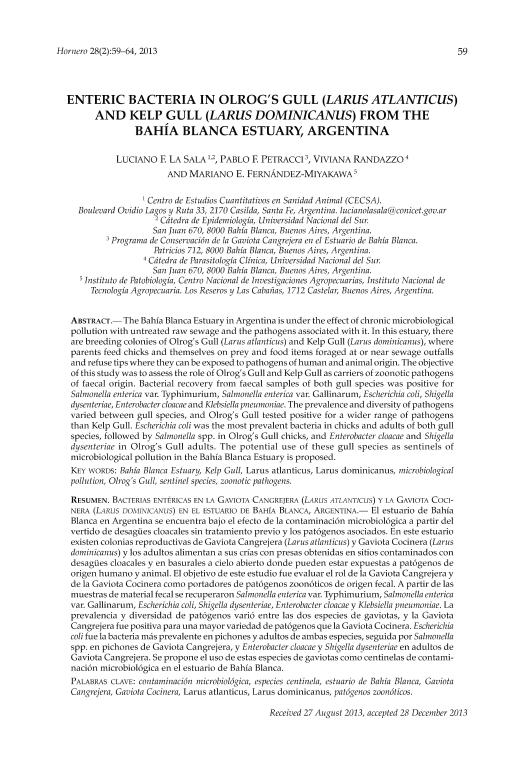Mostrar el registro sencillo del ítem
dc.contributor.author
la Sala, Luciano Francisco

dc.contributor.author
Petracci, Pablo F.
dc.contributor.author
Randazzo, Viviana
dc.contributor.author
Fernandez Miyakawa, Mariano E.
dc.date.available
2017-01-10T22:03:17Z
dc.date.issued
2014-12
dc.identifier.citation
la Sala, Luciano Francisco; Petracci, Pablo F.; Randazzo, Viviana; Fernandez Miyakawa, Mariano E.; Enteric bacteria in Olrog's Gull and Kelp Gull from the Estuary of Bahía Blanca, Argentina; Asociación Ornitológica del Plata; El Hornero; 28; 2; 12-2014; 59-64
dc.identifier.issn
0073-3407
dc.identifier.uri
http://hdl.handle.net/11336/11106
dc.description.abstract
El estuario de Bahía Blanca en Argentina se encuentra bajo el efecto de la contaminación microbiológica a partir del vertido de desagües cloacales sin tratamiento previo y los patógenos asociados. En este estuario existen colonias reproductivas de Gaviota Cangrejera (Larus atlanticus) y Gaviota Cocinera (Larus dominicanus) y los adultos alimentan a sus crías con presas obtenidas en sitios contaminados con desagües cloacales y en basurales a cielo abierto donde pueden estar expuestas a patógenos de origen humano y animal. El objetivo de este estudio fue evaluar el rol de la Gaviota Cangrejera y de la Gaviota Cocinera como portadores de patógenos zoonóticos de origen fecal. A partir de las muestras de material fecal se recuperaron Salmonella enterica var. Typhimurium, Salmonella enterica var. Gallinarum, Escherichia coli, Shigella dysenteriae, Enterobacter cloacae y Klebsiella pneumoniae. La prevalencia y diversidad de patógenos varió entre las dos especies de gaviotas, y la Gaviota Cangrejera fue positiva para una mayor variedad de patógenos que la Gaviota Cocinera. Escherichia coli fue la bacteria más prevalente en pichones y adultos de ambas especies, seguida por Salmonella spp. en pichones de Gaviota Cangrejera, y Enterobacter cloacae y Shigella dysenteriae en adultos de Gaviota Cangrejera. Se propone el uso de estas especies de gaviotas como centinelas de contaminación microbiológica en el estuario de Bahía Blanca.
dc.description.abstract
The Estuary of Bahía Blanca in Argentina is under the effect of chronic microbiological pollution with untreated municipal raw sewage and the pathogens associated with it. In this estuary, there are breeding colonies of Olrog´s Gull (Larus atlanticus) and Kelp Gull (Larus dominicanus), where parents feed chicks and themselves on prey and food items foraged at or near sewage outfalls and refuse tips where they can be exposed to pathogens of human and animal origin. The objective of this study was to assess the role of Olrog´s Gull and Kelp Gull as carriers of zoonotic pathogens of fecal origin. The presence of fecal bacteria was assessed using standard bacteriological methods. Bacterial recovery from fecal samples of both species was positive for Salmonella typhimurium, Salmonella gallinarum, Escherichia coli, Shigella dysenteriae, Enterobacter cloacae, and Klebsiella pneumoniae. The prevalence and diversity of pathogens found varied between gull species and age categories, and Olrog´s Gull tested positive for a wider range of pathogens than Kelp Gull. Escherichia coli was the most prevalent bacteria in chicks and adults of both gull species, followed by Salmonella spp. in Olrog´s Gull chicks, and Enterobacter cloacae and Shigella dysenteriae in Olrog´s Gull adults. This is the first report of enteric pathogens in Olrog´s Gull and provides evidence that these and Kelp Gull act as carriers of human-specific and zoonotic pathogens in the study area.
dc.format
application/pdf
dc.language.iso
eng
dc.publisher
Asociación Ornitológica del Plata

dc.rights
info:eu-repo/semantics/openAccess
dc.rights.uri
https://creativecommons.org/licenses/by-nc-sa/2.5/ar/
dc.subject
Estuary of Bahía Blanca
dc.subject
Olrog´S Gull
dc.subject
Kelp Gull
dc.subject
Larus Atlanticus
dc.subject
Larus Dominicanus
dc.subject
Microbiological Pollution
dc.subject
Zoonotic Pathogens
dc.subject.classification
Biología Celular, Microbiología

dc.subject.classification
Ciencias Biológicas

dc.subject.classification
CIENCIAS NATURALES Y EXACTAS

dc.title
Enteric bacteria in Olrog's Gull and Kelp Gull from the Estuary of Bahía Blanca, Argentina
dc.type
info:eu-repo/semantics/article
dc.type
info:ar-repo/semantics/artículo
dc.type
info:eu-repo/semantics/publishedVersion
dc.date.updated
2016-12-07T18:01:35Z
dc.journal.volume
28
dc.journal.number
2
dc.journal.pagination
59-64
dc.journal.pais
Argentina

dc.journal.ciudad
Buenos Aires
dc.description.fil
Fil: la Sala, Luciano Francisco. Universidad Nacional del Sur. Departamento de Biología, Bioquímica y Farmacia; Argentina. Centro de Estudios Cuantitativos en Sanidad Animal; Argentina. Consejo Nacional de Investigaciones Científicas y Técnicas; Argentina
dc.description.fil
Fil: Petracci, Pablo F.. Programa de Conservación de la Gaviota Cangrejera en el Estuario de Bahía Blanca; Argentina
dc.description.fil
Fil: Randazzo, Viviana. Universidad Nacional del Sur. Departamento de Biología, Bioquímica y Farmacia; Argentina
dc.description.fil
Fil: Fernandez Miyakawa, Mariano E.. Instituto Nacional de Tecnologia Agropecuaria. Centro Nacional de Investigaciones Agropecuarias. Centro de Investigación de Ciencias Veterinarias y Agronomicas. Instituto de Patobiologia; Argentina
dc.journal.title
El Hornero

dc.relation.alternativeid
info:eu-repo/semantics/altIdentifier/url/http://ref.scielo.org/4tcn66
Archivos asociados
